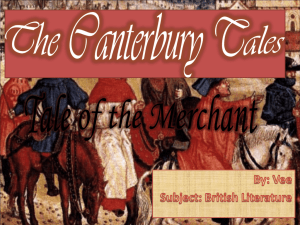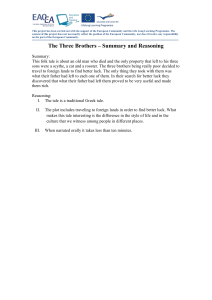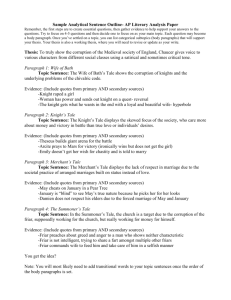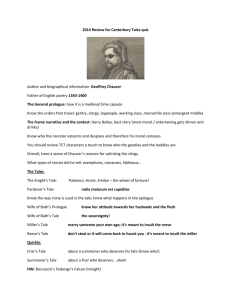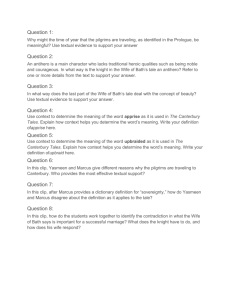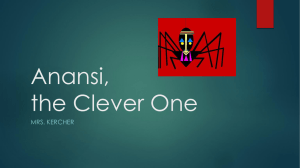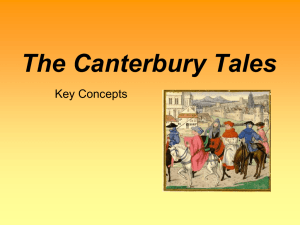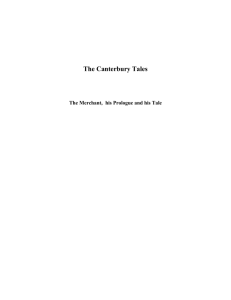CANTERBURY TALES – THE MERCHANT`S TALE
advertisement
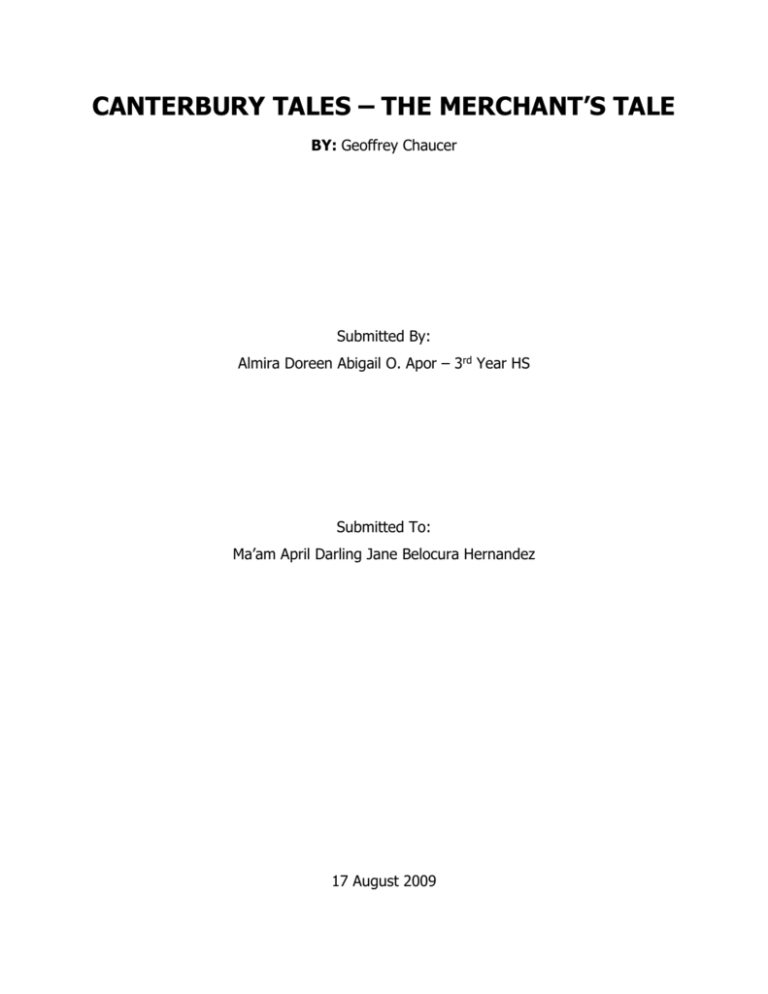
CANTERBURY TALES – THE MERCHANT’S TALE BY: Geoffrey Chaucer Submitted By: Almira Doreen Abigail O. Apor – 3rd Year HS Submitted To: Ma’am April Darling Jane Belocura Hernandez 17 August 2009 CANTERBURY TALES – THE MERCHANT’S TALE I. Characters The characters in this tale are quite few. The protagonists are: the Merchant and January. The Merchant is the narrator if the tale; hence, it is called ‘The Merchant’s Tale’. Through his work, he shows that he has a clear understanding and several opinions on marriage which he has derived from previous experiences – either from him or from somebody else. Most often, his opinions and insights are contradictory. January is not the Merchant personified in the tale; rather, January is one of the characters used by the Merchant as a symbol to prove his points, but he is the main viewpoint character. In the tale, January is depicted as a knight born in Pavia that resides in Lombardy. He has been for 60 years wifeless. While he holds several convincing thoughts on the prospects of marrying after 60 years, he does not seem to show any rationality towards his choice of wife, indicated by how he simply requested for a woman brought to him so that ‘they may wed’. He lives up to the impression his name gives – old, susceptible, and oblivious to the truth to the point of ignorance. As for the antagonists, the people who hinder the protagonists from achieving their goal, they are: May and Damian. May is considered an antagonist because although she originally appears to be blameless and innocent, she ends up further in the tale as an immoral wife with no fidelity towards her husband. She is depicted to be very beautiful yet very disloyal. She is a young, ordinary village girl who January happened to see, and thus, she ended up his wife. She is unfaithful towards January by ‘falling in love’ with Damian for the lack of a less crude term. Damian is an antagonist because he is the one emphasized in the tale to have brought May to infidelity after her marriage to January. He is a servant of January, but he is insubordinate. He lies that he is sick in bed, and goes as far as deceiving his master of his affairs with May. He is one who is unscrupulous and tricky – Machiavellian, to be exact. The minor characters include: Placebo, Justinus, January’s men, Pluto, and Proserpine. Placebo is one of January’s brothers. He is a supportive sibling, agreeing with January’s decisions on marriage as well as his method on it. His name significantly means ‘I shall please’. Justinus, on the other hand, is opposite Placebo in his opinions. He is also a brother of January, and he does not agree with January’s prospects on marriage, mainly due to his despair caused by his own wife. He seems to be caring enough to share his insights on marriage to his brother in order to avoid him falling into the same demise. January’s men are like his counselors. He goes to them to seek advice and their opinions on the thought of him marrying. They all seem loyal with the exception of Damian who is obviously not as loyal as the rest. Pluto is the god of the underworld in Roman mythology. Here, he is portrayed to someone who strongly believes that women are by nature disloyal. He sides with January after seeing his wife cheating on him with another man and grants January his sight back so he may fully see the treachery his wife has been committing all that time. He seems to be a strongwilled god, eager to point out the number of time women have committed infidelity to his own wife Proserpine. And here, Proserpine is the wife of Pluto. Roman mythology states that she was the daughter of Ceres, goddess of agriculture, who was swiped away by Pluto after being infatuated by her beauty. This may be supporting proof enough as to why Proserpine sides with May in this tale. While Pluto was the one responsible for having January acknowledge the hidden side of May, leading to his interrogation, Proserpine is the one responsible for giving May the appropriate response to January’s question on her adulterous acts. II. Conflict The conflict of the tale here is wholly Man vs. Man. Supporting details include May’s infidelity, Damian’s insubordination, and Justinus and Placebo’s debate on whether January should marry or not. Pluto and Proserpine are represented here to be seemingly human; therefore, we cannot say it is Man vs. God because neither Pluto nor Proserpine are main characters, and their conflict is the mildest. III. Plot IV. Summary The tale itself begins with an introduction on January, a recent Christian convert, who is thinking about taking a wife, which fuels a debate between his two brothers. He sees May and takes her as a wife, but soon after his servant Damian falls for her, and the two become lovers, unknown to January. Shortly after that, January loses his sight, and one day, May takes January out to the garden in order to meet with Damian up a pear tree, yet January is unaware of this plan since he is blind and old. Pluto chances upon the two and pities January, granting him his sight back in order for him to see the misdeed of his wife, yet his wife Proserpine antagonizes him by giving May the appropriate response to January’s interrogation. In response to what May told him, he could not respond in a fit of anger because he was unsure of what he saw and he believed her, so instead forgives her, marking the end of the Merchant’s Tale. V. Reflection The character that I seemingly admire at the very least is Pluto. Although he is the god of the underworld and has kidnapped Proserpine, he was able to show pity towards January. Ironically, he dealt justice in a sense between the married couple by giving January his sight back. What I admire in him is that he is an irony in himself. He is nearly the god of chaos and has committed mischief in the past, according to Roman mythology, yet he was able to feel pity and understanding. He brought justice, which is something no harbinger of chaos would do. Yet although his attempt was foiled by Proserpine, it was brilliant of him to even try. There are quite a number of values in this tale. The first is decisiveness and rationality. Had January been more decisive, he would not have been met with the demise of a disloyal wife. Had he been more rational on the thought of marriage, he would not have married at all; thus, sparing him of May and her felony. The second is measuring the true value of things. If only January had not been blind and had not been swept by May’s appearance, he would not have been deceived by her even until the end. Had he measured the pros and cons of marriage, this tale would not have developed. The third is truthfulness. It is wrong to deceive others, and it is very immoral to lie about a grave misdeed. What May had committed with Damian is extremely sinful, and she should have been damned by Pluto, god of the underworld, the moment he saw her crimes, yet it is a shame that gods cannot interfere directly with the affairs of mortals. The fourth is loyalty and knowing when to seek help. This is closely followed by humility. The tale conversely shows loyalty, meaning that it implies that we must be loyal whilst it shows disloyalty and deceit. It also shows that even the most gallant of knights know when to seek counsel. This is under no implication that January is indeed a gallant knight, but nevertheless, it was wise of him to seek the opinions of his subordinates in order to derive a firm decision. Knowing when to seek counsel is closely followed by humility because it is sometimes troublesome for one of higher dignity to listen to people of lower dignity. Above all, this tale bears several values, perhaps even more that what I have cited, and better than above all, these values are applicable even to our modern life. This is the true beauty of the Canterbury Tales.
